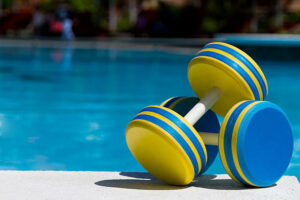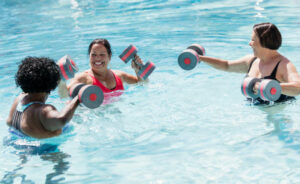Beat the Heat with a Water Workout
go.ncsu.edu/readext?1077869
en Español / em Português
El inglés es el idioma de control de esta página. En la medida en que haya algún conflicto entre la traducción al inglés y la traducción, el inglés prevalece.
Al hacer clic en el enlace de traducción se activa un servicio de traducción gratuito para convertir la página al español. Al igual que con cualquier traducción por Internet, la conversión no es sensible al contexto y puede que no traduzca el texto en su significado original. NC State Extension no garantiza la exactitud del texto traducido. Por favor, tenga en cuenta que algunas aplicaciones y/o servicios pueden no funcionar como se espera cuando se traducen.
Português
Inglês é o idioma de controle desta página. Na medida que haja algum conflito entre o texto original em Inglês e a tradução, o Inglês prevalece.
Ao clicar no link de tradução, um serviço gratuito de tradução será ativado para converter a página para o Português. Como em qualquer tradução pela internet, a conversão não é sensivel ao contexto e pode não ocorrer a tradução para o significado orginal. O serviço de Extensão da Carolina do Norte (NC State Extension) não garante a exatidão do texto traduzido. Por favor, observe que algumas funções ou serviços podem não funcionar como esperado após a tradução.
English
English is the controlling language of this page. To the extent there is any conflict between the English text and the translation, English controls.
Clicking on the translation link activates a free translation service to convert the page to Spanish. As with any Internet translation, the conversion is not context-sensitive and may not translate the text to its original meaning. NC State Extension does not guarantee the accuracy of the translated text. Please note that some applications and/or services may not function as expected when translated.
Collapse ▲Yeah! Summer is here. What a great time to enjoy the outdoors and stay
active, but the heat can also make it a bit challenging.
Heat can present an added challenge when doing outside exercises and activities such walking, running, biking and other aerobic activities that get the heart and lungs pumping. However, many of us have access to a pool in the summer. And, of course we have the warmer ocean water. Jump in.
 A pool is where you’ll frequently find me! Water fitness is my favorite exercise. You may think that this is something just for older people but there are different exercises and classes for all ages and fitness levels. Exercising in the water can help develop flexibility, muscular strength and endurance as well as offering cardo-respiratory benefits. Other physical benefits include increased range of motion, balance and coordination and relaxation.
A pool is where you’ll frequently find me! Water fitness is my favorite exercise. You may think that this is something just for older people but there are different exercises and classes for all ages and fitness levels. Exercising in the water can help develop flexibility, muscular strength and endurance as well as offering cardo-respiratory benefits. Other physical benefits include increased range of motion, balance and coordination and relaxation.
While it may seem obvious to say this, but exercising in water differs from exercising on land. These differences create a great environment for a fitness program.
 RESISTANCE. Since the viscosity of water is greater than that of air, the resistance to movement is greater. Water provides 12 to 14 times more resistance than the air does with land exercise. This resistance is also evenly distributed. Water works the opposing muscle as well. Kickboards, water weights or water noodles are often used to create additional resistance for strength building. Jumping jacks in the water are a great way to utilize the resistance. Do these as you would on land, but don’t let your arms come out of the water.
RESISTANCE. Since the viscosity of water is greater than that of air, the resistance to movement is greater. Water provides 12 to 14 times more resistance than the air does with land exercise. This resistance is also evenly distributed. Water works the opposing muscle as well. Kickboards, water weights or water noodles are often used to create additional resistance for strength building. Jumping jacks in the water are a great way to utilize the resistance. Do these as you would on land, but don’t let your arms come out of the water.
INERTIA. This is the force needed to move from a stopped position or to change direction. In water fitness the inertia is against both the water and current. Once the momentum in one direction has been achieved it takes additional energy reverse the direction of motion. Taking advantage of this can be as simple as traveling back and forth with some speed, changing direction and perhaps do the movements backwards.
BODY SURFACE AREA. The water itself creates drag as it moves against the body, this can intensity the workout. Moving through the water creates more drag. Equipment such as webbed gloves and paddles increase these drag forces of the water.
THERMAL REGULATION. The water naturally cools the body down and therefore the body’s core temperature tends to be lower. Even when\ working hard, you don’t realize your sweating. This can help prevent you from overheating. But, even surrounded by water you can get dehydrated—be sure to bring some water to drink.
INTENSITY. The intensity of a workout can be increased or decreased with speed. Also moving/traveling across the pool and into deeper water increases intensity. Try some exercises standing at chest depth, then go deeper so your shoulders are under the water and (for even most intensity) do exercises with your feet off the bottom of the pool.
BUOYENCY. This is one of the major positives about water fitness. In water the body has buoyancy and makes water fitness easier on joints and bones. Because of this buoyancy, participants can jump without the limitation of gravity and the fear of falling and getting hurt. Being submerged or partially submerged gives more and enhanced range of motions and freedom of movement. All of this allows workouts become less painful.
 You can do pool exercises on your own. There are some on-line programs you can follow or develop your own routine. Group water fitness classes can be found at many community pools during the summer. These classes can stretch beyond basic water aerobics and include classes such as aquatic dance, aquatic boxing and aquatic yoga. I’ve even heard of classes and movements designed specifically for men called “Dude Moves”. There are also often classes tailored to those with specific concerns such as arthritis.
You can do pool exercises on your own. There are some on-line programs you can follow or develop your own routine. Group water fitness classes can be found at many community pools during the summer. These classes can stretch beyond basic water aerobics and include classes such as aquatic dance, aquatic boxing and aquatic yoga. I’ve even heard of classes and movements designed specifically for men called “Dude Moves”. There are also often classes tailored to those with specific concerns such as arthritis.
If you struggle with exercising outside in the summer heat, why not switch up your exercise routine and head from the water? Whether you do it on your own, in a group class or with family and friends, keep it fun and enjoy the summer sun!
Resources
- Eat Smart, Move More
- Royal Swimming Pools: Top 18 Swimming Pool Exercises
- Aquatic Exercise Association
- Pool Fit: Exercise in The Pool
Syracuse is a Family and Consumer Science team member and can be reached at N.C. Cooperative Extension, Brunswick County Center 910-253-2610 or by email at clsyracu@ncsu.edu



